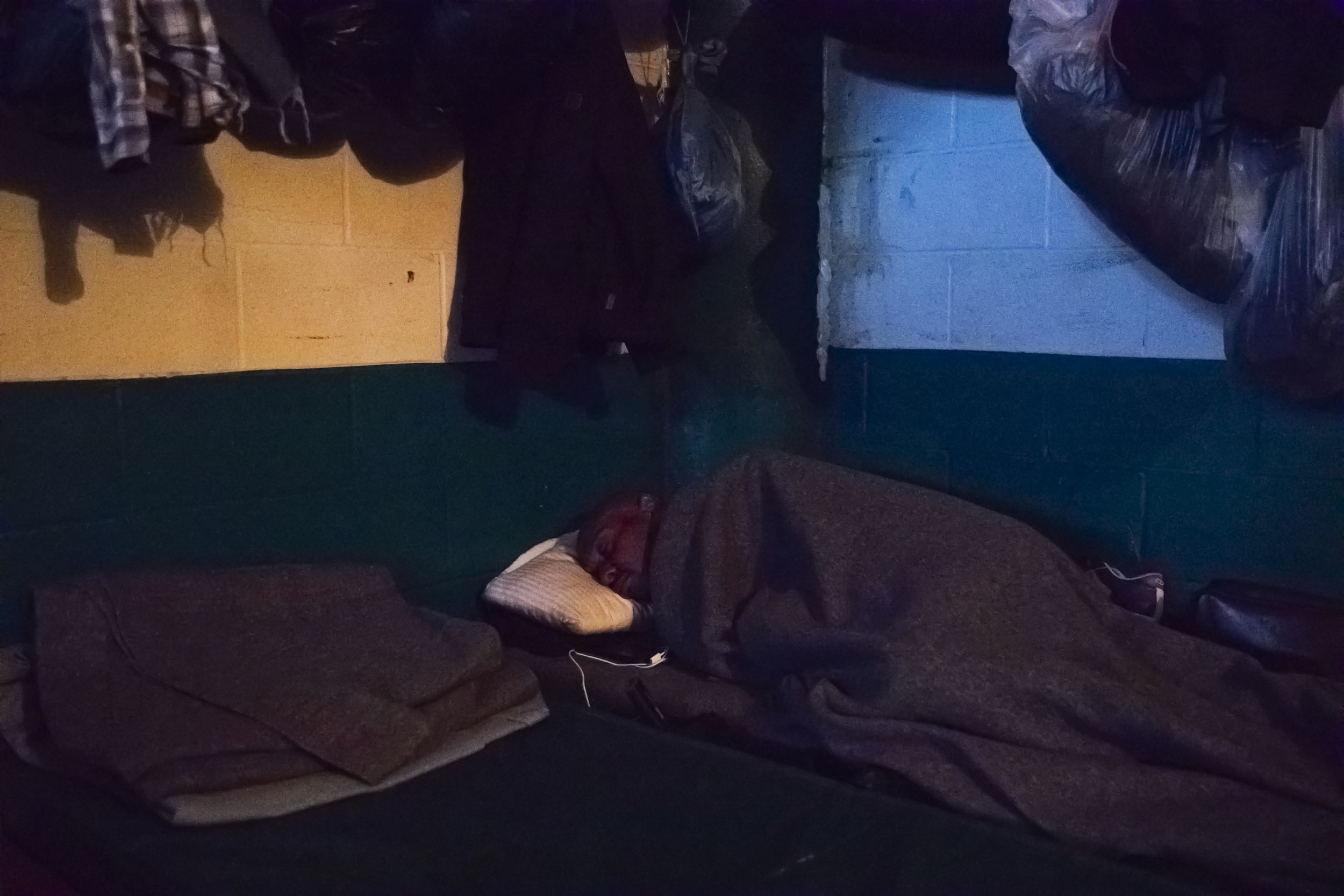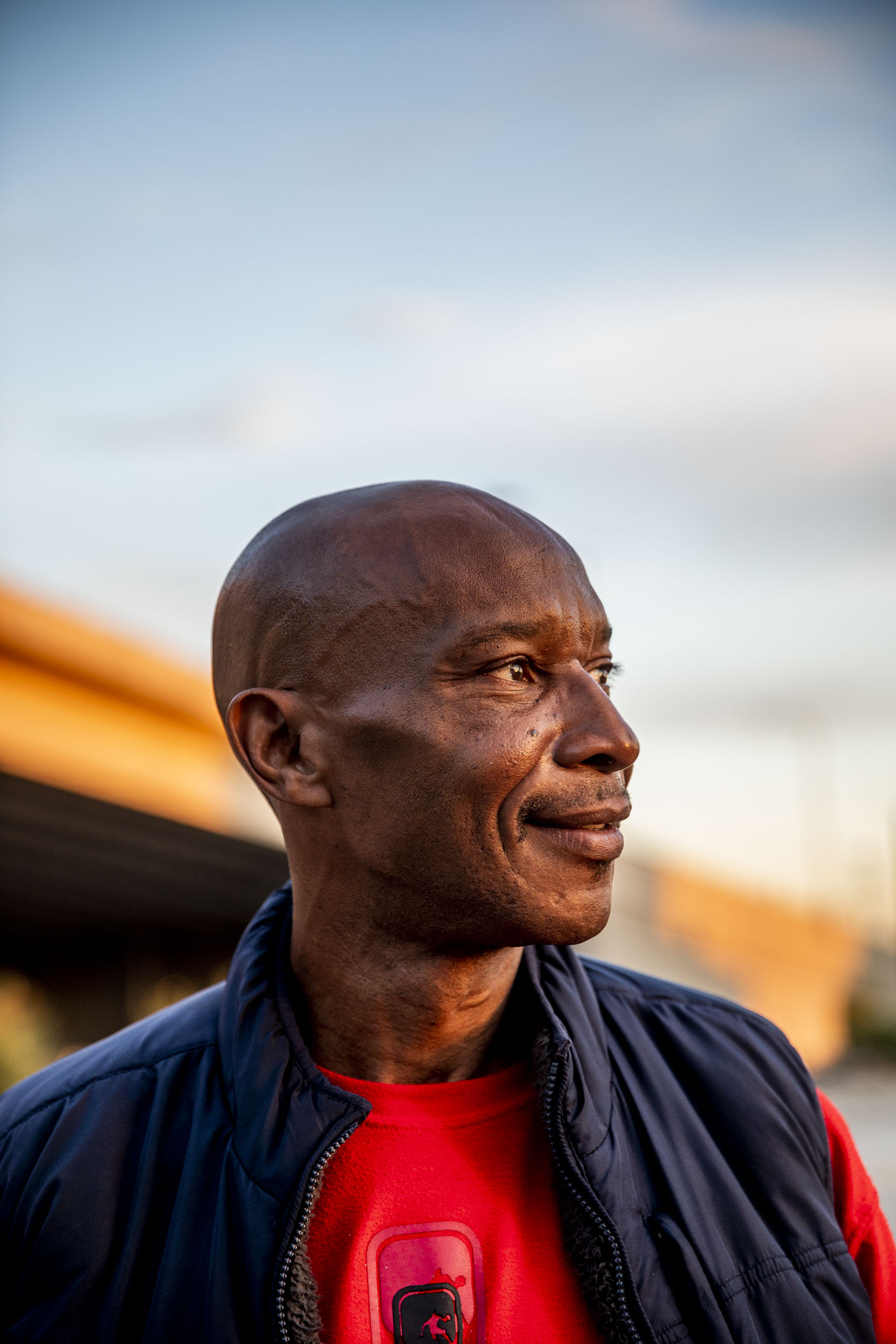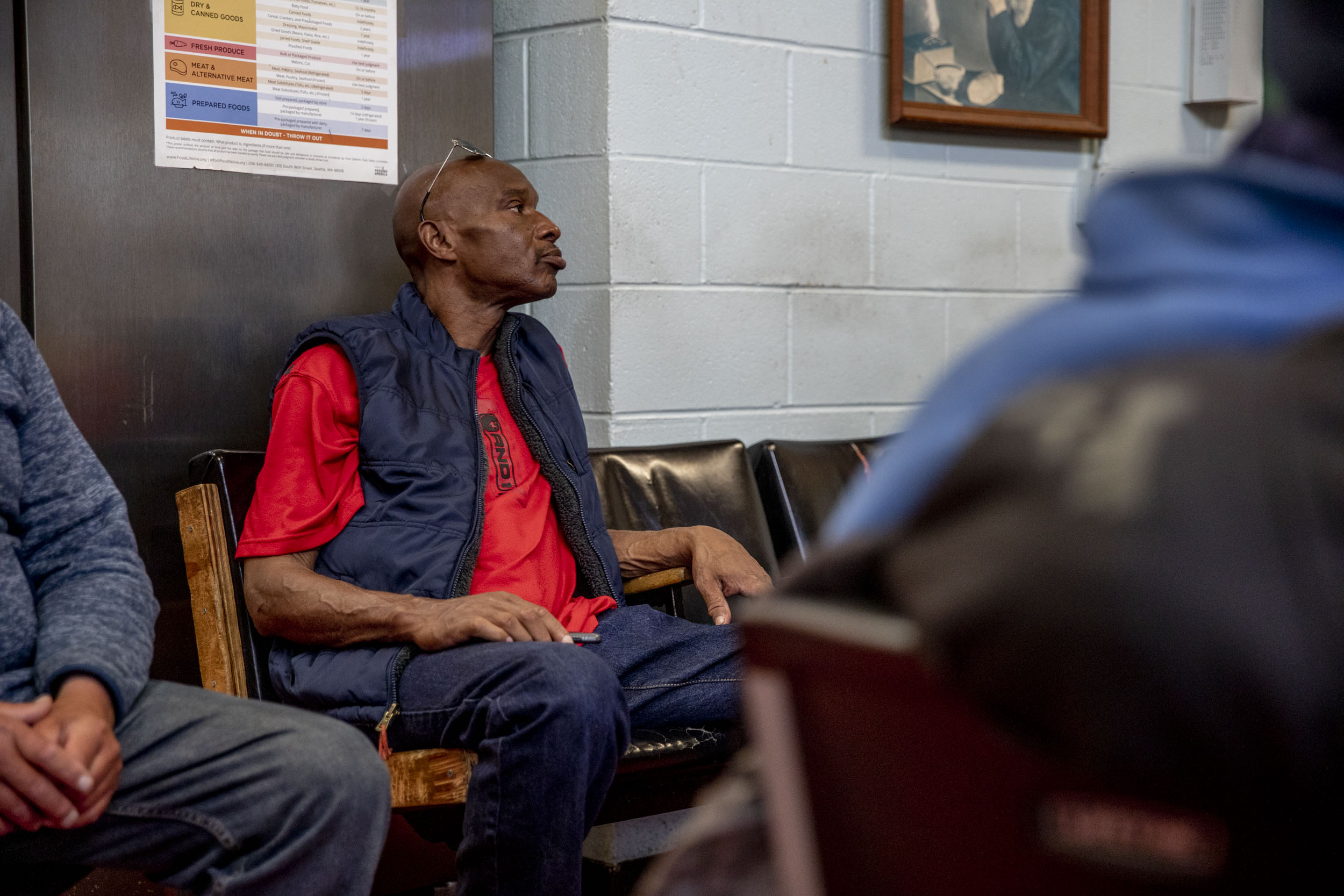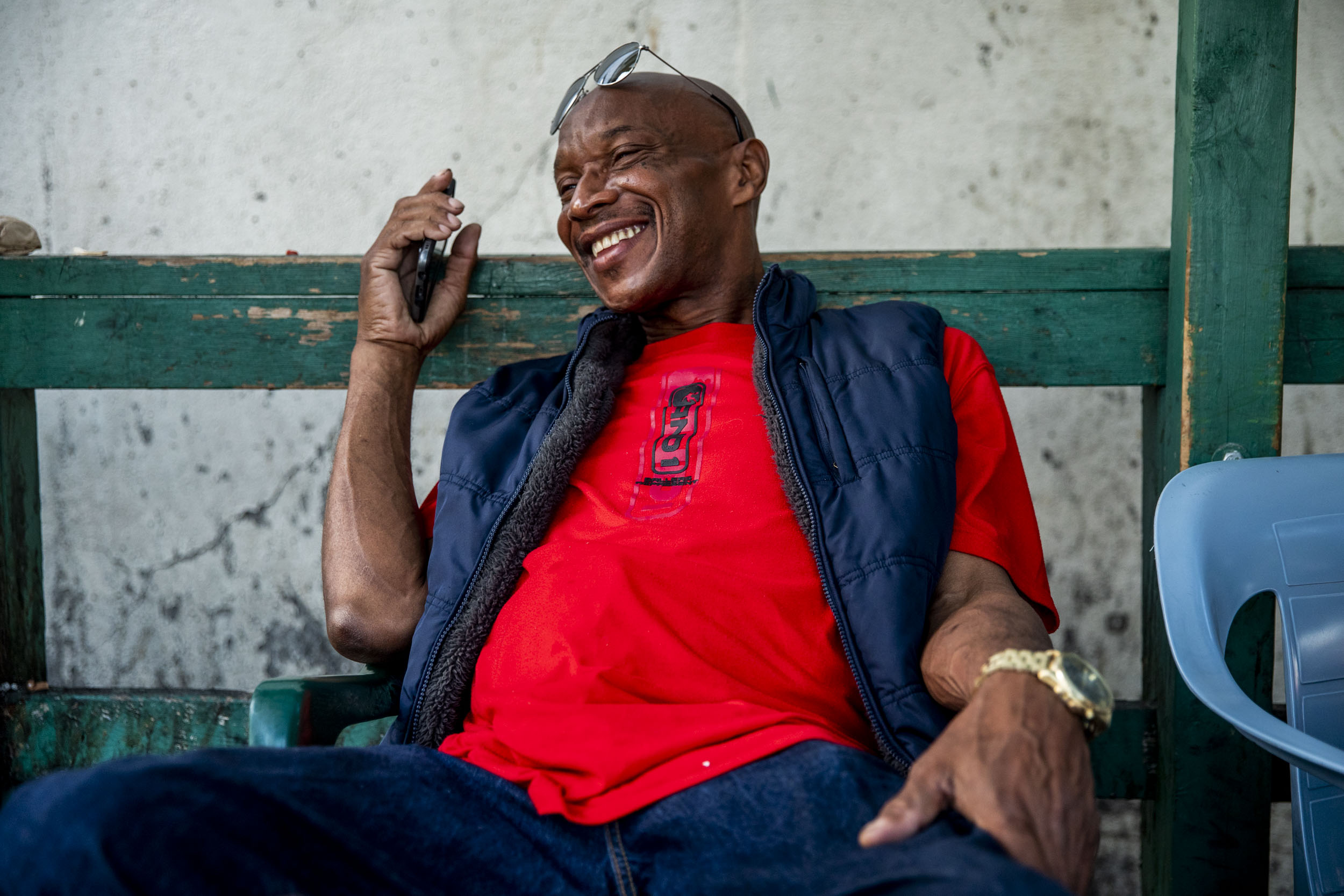Daniels wears an ostomy bag now. Hidden beneath loose-fitting clothes, the bag rests near his stomach, a tube connecting it to his small intestine. It collects waste, gas and air, all of which Daniels empties during regular visits to the restroom throughout the day and night. Gesturing toward it, he compares it to a child that needs constant attention.
If he had a bed, he says, he could swing his legs to the side and use the momentum to stand on his feet for his frequent nighttime visits. But the slender 56-year-old — who holds strong eye-contact as he speaks — doesn't have a bed. What he has is one of 212 mats spaced just inches apart on the floor of the St. Martin de Porres Shelter, housed in a gray building in Seattle’s industrial SoDo neighborhood.
"It's better than being on the street, living in a tent," said Daniels. "But it has its disadvantages when it comes to the realistic necessity that's best needed to make things more comfortable for me."
Daniels received some good news recently: He likely would not need to undergo chemotherapy. He has received some bad news as well: Even if the state approves his disability claim, the waiting list for housing can sometimes stretch on for years. The effects of the surgery, it turns out, may continue to ripple through his life, even as his health begins to return.
Among those who spend their nights at St. Martin de Porres, which exclusively serves men over 50, Daniels' compromised health is not unique. There's Larry Perkins, 60, who had a cancerous piece of his lung removed and went through chemotherapy while sandwiched between his neighbors on mats. There's Michael Charney, 63, who said he sometimes has seizures in addition to his congestive heart failure. There's Jerry Kies, 75, whose heart, he said, is 52% atrophied and whose lung capacity is depleted by a third.
For Jennifer Newman, program director of St. Martin de Porres, it can feel overwhelming. The shelter has hosted clients on kidney dialysis, she said. One has terminal lung cancer. While she cares deeply about the shelter's success, she's the first to say this is not the right place for these men.
"To treat our elders this way, regardless of whatever mistakes or mishaps they may have had in their life, is just criminal and grotesque to me," she said.
Homeless service providers across the city largely agree: Their clients are getting older and, therefore, sicker.
In a survey of over 1,000 people struggling with homelessness in King County, conducted as part of the county's annual point-in-time count, 64% reported living with one or more health conditions. Another 27% called their health issues "chronic," and 23% said they had at least one physical disability, compared with an estimated 6.4% of the general population.
Seventy-three people considered homeless died of "natural" causes last year, such as cancer and cardiovascular issues, according to the King County Medical Examiner. That’s the largest killer of homeless people and double the number from 2012. In all, 113 of those considered homeless who died last year were over 50 — 58% of all homeless deaths.

Noah Fay, director of housing programs with the Downtown Emergency Service Center (DESC), said that on a given night 18% to 30% of the center's shelter clients are referred directly from either a hospital or an emergency responder. The medical needs of 10 to 12 clients a night far exceed what staff is equipped to handle, he said, but the clients often are accepted because the alternative is the street.
"It is not hard to notice just the [severity] of issues people are dealing with," Fay said. "We are seeing people's end-of-life issues in facilities that are just not designed to meet those needs."
The range of health issues facing people living without shelter is limitless — from cancer, to heart failure, to mental and behavioral impairments, to substance abuse. There are the sudden and serious issues such as Daniels' cancer. And there are the chronic issues, including traumatic brain injuries, diabetes, PTSD. Sometimes there are both.
Many problems are exacerbated by some combination of age, substance use and the prolonged exposure that can come from living outside for years. And sometimes, it's the health issues that lead a person to become homeless in the first place.
As this wave of medical severity swells, shelters and housing providers in the area are struggling to keep up. There are medical professionals, programs and clinics scattered throughout the system but, as a whole, doctors and service providers agree there aren't enough.
"The result of that is staff that are completely overwhelmed because they're dealing with things that a personal-care aid should be doing, people that are trained to do this kind of thing on a one-to-one basis," said Emily Katz, nurse manager with DESC.
Service providers say the city needs more housing, especially facilities with on-site case managers and basic medical care. For many of their clients, that would be enough. Such a setup would provide Daniels with his own bed, his own bathroom and maybe a medical professional who visits him as he works toward recovery.
For some aging and chronically sick clients, however, a skilled nursing facility, adult family home or nursing home would be the most appropriate location. And yet, when asked how many such facilities that would serve their homeless clients exist, the providers Crosscut spoke with said none.
The near-unanimous sentiment among those who work with homeless populations: This is a crisis within a crisis.
The homeless population is aging, a phenomenon that has unfolded nationally over decades. A 2013 study found that 1 in 3 men sleeping in shelters in Boston, New York and Los Angeles County in 2010 were over 46, compared with 1 in 8 in 1990. An ongoing study of homeless individuals in the San Francisco Bay Area found that, in 1990, 11% of people struggling with homelessness were over 50. That number is now over 50%.
Providers in the Seattle area see it too. Fay said DESC's average age has jumped from the 30s ten years ago to about 50 today.
It's not that there is a static group of people living on the streets and in shelters without changing their station in life. It's that people are falling into homelessness at a later stage of their lives than those who did in previous decades. Dr. Margot Kushel, director of the Center for Vulnerable Populations at the University of California, San Francisco, says this phenomenon has been years in the making.
"People born in the second half of the baby boom, about 1955 to 1964, have always been at elevated risk," she said. The early baby boomers snapped up many of the best jobs, she said. Combined with the weakening of unions, the federal government's divestment from public housing and the tough-on-crime early 1990s, later boomers were derailed from building up the same level of savings or pensions than those slightly older. So as rents and cost of living have spiked along the West Coast in recent years, those same people are extremely vulnerable to falling into homelessness.
This is the story of many of the men in St. Martin de Porres.
Daniels spent much of his life working as a mover in cities across the country — Atlanta, where he grew up; Las Vegas; Minneapolis; San Diego. Before he came to Seattle about a year and a half ago, he was living in San Francisco.
And for most of that time, that lifestyle worked for him. He never saved much and certainly didn't earn a pension, but he was happy. His mental health was good and he didn’t struggle with substance abuse. He’d had a brief period of homelessness in Minneapolis several years ago, but he was generally employed and housed. "I don't have a lot of material things, but I lived a great life," he said.
But San Francisco, a city he loves, was too expensive. He was making $25 an hour while paying $1,800 for a "closet" and barely scraping by. So he thought he'd try Seattle, where he had once spent eight months and had friends.
He stayed with friends and found a full-time job. But he clashed with the owner of the company where he worked. He struck out on his own, figuring he could piece together enough work as an individual contractor. It was slow at first, and he moved into St. Martin de Porres, not wanting to burden friends. Still, he continued to work and expected things to pick up, with a new apartment to follow.
And then a pain in his abdomen grew. He felt the urge to go to the bathroom, but couldn't. He ate a box of laxatives and guzzled prune juice, but nothing passed and the pain persisted. Eventually, the bloating was so bad, he called an ambulance, which took him to Harborview.
That's when his doctors found the tumor blocking his colon and 32 polyps that raised concerns.
Daniels says he spent two months in the hospital, losing 40 pounds. Three months after surgery, he says he still feels weak and sore all the time. His career as a mover is surely over, he acknowledges.
He lingers in the overnight shelter during the day – a courtesy offered to up to 10 guests on medical respite – and waits to hear if he will qualify for disability, which would provide him with about $700 a month. That won't be enough to pay rent on the open market, of course, so he will work with a case manager to put it toward subsidized housing, as many thousands of others in the city are trying to do.

"This is better than being on the street," he said of the shelter. "This is a place where no matter what happens, at least you can jump in the shower and clean yourself up. But, you know, if I was in my own place and if I had access to the things that's needed, I wouldn't have to worry about waiting on five people before I can use the sink, you know what I mean? [Now] I may go into the restroom at any given moment and 10 people are in line and I need to do it right away, but there I go," he said, mimicking a spill from his colostomy bag.
Where can someone who is sick and homeless go? Local agencies have been asking this question for years now. An April 2016 paper from King County's Health Care for the Homeless Network said providers at every level were "ill-equipped to address widespread issues related to memory loss and other conditions that impact residents’ ability to independently perform activities of daily living as well as end-of-life care needs."
Even permanent housing with wraparound services was "not designed with the special needs of seniors in mind," the paper said.
"Our whole homeless provider system, whether it be shelters or permanent supportive housing units, was really designed around this idea that they would be caring for people in their 20s, 30s and 40s with substance use and mental health problems," said Dr. Kushel of UCSF. "And instead they're caring for people who are in their 50s, maybe early 60s, but health-wise really are more like their 70s or 80s for what we would expect and they're just not prepared."
The result is often a juggling act of bad options, from keeping the ailing for extended periods in the hospital, sending them to a shelter or risking that they may end up on the street.
"You have Harborview calling DESC saying, 'We have this woman in an electric wheelchair who, by the way, needs to have a BiPAP at night, so she needs a place to plug in,' which they don't have," said Dr. Nancy Sugg, medical director of Harborview's Pioneer Square Clinic and Downtown Homeless Programs. "And she might need to be on home oxygen, which, where do you put that in a shelter? There's no place to put her. There's no housing, there's no adult family home that she will be able to go to and she has these needs and so the shelters are asked to do that."
On any night, said Sugg, 30 to 40 Harborview beds — a whole wing — are filled with patients who would normally be discharged, a situation common to all of the city's hospitals.
Shelters like DESC may reserve the right to turn away overly complicated patients. But DESC's Katz said hospitals — to varying levels — sometimes downplay the severity of the issues facing clients or even threaten to discharge them to the streets in order to move them out of their care. But once a client arrives for intake, the staff is loathe to turn that person away.
"It's this constant game of chicken, of trying to figure out who's going to call our bluff, basically," she said. "Because we'll say, 'No, this person is out of scope for the shelter staff.' And hospitals will say, 'Fine, we'll discharge them to the street then.'"
Katz added that DESC also experiences "hospitals not being completely truthful with what was going on with the client. So they underplay or outright say, 'Yeah, they're perfectly independent and able to transfer from their wheelchair to the bed or from their wheelchair to the toilet,' when they actually can't. And then they come and they've got like a broken right hip and dementia and they can't move themselves at all."
Harborview's Sugg said she hoped her hospital would be transparent and not issue threats, but acknowledged she has heard that it happens at some hospitals.
"It doesn't feel like it's malicious," Katz said. "It just feels like it's something that, on many levels, is dysfunctional."
When clients with complex medical needs do show up, the staff uses an intake form to assess whether to accept them. But for the past several months, DESC has been without its normal on-site nurse or advanced registered nurse practitioner (ARNP). The nurse was promoted to a different role and DESC has struggled to find a replacement. And the ARNP was funded through a grant that will soon run out. The staff is hoping Harborview picks up the tab to keep the position, but it hasn't happened yet.
"It's now just shelter staff 100% of the time doing hospital screening," not medical professionals, said Katz. And it's those staff who "sometimes have very little experience or are getting paid not enough, just above minimum wage, that are dealing with the chaos of 250 people and a hospital staff calling in and saying, 'Yeah, this person's fine'" when sometimes they’re not.
As the medical severity increases, the staff's already-limited energy is more often pulled toward a small group of clients. DESC's Fay recalled one occasion when it took the staff three tries to get a client to an appointment for a Social Security card because the person often soiled himself and needed help to clean up first.
That level of attention makes the overall environment less safe, said Katz.
Many of these clients would qualify for and benefit from a skilled nursing facility, Sugg said, one where they could continue rehabbing for several weeks outside of a hospital setting. But there's a problem there as well.
"Skilled nursing facilities can't discharge to the street or to shelters," she said. "So if you're a skilled nursing facility and I call you and say, 'Can you take this patient, they broke their leg, they just need four weeks,' are you going to take them? No."
Adult family care centers or nursing facilities could also be an appropriate landing place for some patients. But Sugg said she couldn't think of any that would accept many homeless patients, for a variety of reasons. For one, Medicaid reimbursements are low and are often not increased when a client has behavioral issues.
Additionally, unlike some shelters or housing programs, senior-care facilities in the region are weary of accepting clients who might still be using substances or have a criminal history. One reason is that it may make other clients uncomfortable, but there is another major explanation: state regulations. If someone overdoses, the facility or program could lose accreditation. As a result, risk is less tolerable. In recent years, facilities have even gone so far as rejecting patients who smoke, said Sugg, for fear of an oxygen tank explosion.
"It's a risk for them, it's a risk for their license," said Sugg.
The challenges of medical acuity among the homeless population are well known. Hospitals and service providers have sought and experimented with solutions in response.
Harborview runs a medical respite program, the Edward Thomas House, for people struggling with homelessness who no longer need to be in the hospital. It opened in 2011 and serves as a place for people to recuperate. Providers point to it as a model that should be expanded.
But while promising, there are currently only 34 beds.
King County's Healthcare for the Homeless Network places medical professionals inside organizations and housing around the county to help with medical acuity. It also runs a mobile medical clinic and a palliative care program. The network has grown in recent years. Still, John Gilvar, manager of the Health Care for the Homeless Network, said scaling it up to the level that's necessary is difficult, in part because of the logistics of using Medicaid dollars for the work.
"That's really the challenge, the way Medicaid is structured, services are provided in an office setting by certain eligible providers, so there's almost a perverse incentive to build clinics that can crank out the billable hours," Gilvar said. "That kind of clinic is not what's needed for the homeless population."
Last year, in partnership with Harborview, DESC opened the Estelle — a permanent supportive housing project with additional medical care. Plymouth Housing also runs Plymouth on First Hill, tailored toward adults with complex medical needs. Earlier this year, Plymouth announced $15 million in donations from three medical institutions to help build more supportive housing. One of its projects will be tailored toward seniors.
All of these efforts are viewed as essential. But there’s a feeling among providers that they are patches, not the comprehensive net that’s necessary.
"We don't have enough Estelles, we don't have enough supportive care, we don't have enough money going into health care and policy where you actually have health care on site in those housing units," said Sugg.

Jennifer Newman, the program director of St. Martin de Porres, remembers one man who stayed at the shelter for a time. He was in his 70s, undocumented and had spent much of his life working in restaurants, receiving his pay under the table.
He came to the shelter after suffering a stroke. It had left him unable to work and, because he was undocumented, he wasn’t able to file for disability.
A rehabilitation facility worked with him for as long as it could, but he couldn’t pay so he was eventually cut off. Still, he was motivated and in the time he stayed with the shelter, Newman and the other staff would watch as he did his exercises daily.
"He wanted so badly to go back to work," said Newman. "He would do his physical therapy everyday. That's all he did was sit there and work with his hands and try to regain his walking again because he wanted to go back to work and get out of the shelter. He had never been in a shelter before."
But he wasn't progressing enough without help and it became clear he would not likely return to work. Case workers tried to find him housing but, between his undocumented status and the level of care he needed, Newman said it was "an impossible task to find him somewhere to live."
The man grew increasingly depressed. One day, he developed a stomach infection and was taken to the hospital. Staff were making progress finding a place for him to live, says Newman, but by that point, he no longer believed them. He refused to eat or accept treatment, and Newman and the others at St. Martin de Porres watched as the man who had once been so focused on his own rehab slipped away and died in the hospital.
"It made a lot of us kind of question of what we're doing," said Newman. "I love the work I'm doing, but how do you keep doing this when a society…." Her voice trailed off. "It's just heartbreaking."
The man’s name was etched onto a cross and pinned inside the shelter’s temple near the back of the building, joining the more than 400 memorials already there. The walls of the small room are filling with crosses.
Research suggests the population will continue to age until 2030. It will crest then only because those struggling with homelessness who were born in the latter half of the baby boom will die.
For Dr. Kushel of UCSF, the current pace of action will likely lead to one of two things:
"We are either going to see a whole bunch of people just moving into our overburdened nursing homes — and there just aren't enough of them — to the tune of $100,000 a year or we're going to see older adults incontinent, with dementia, unable to see or hear, unable to walk, living outside — unless people act quickly. And we're not acting quickly."








